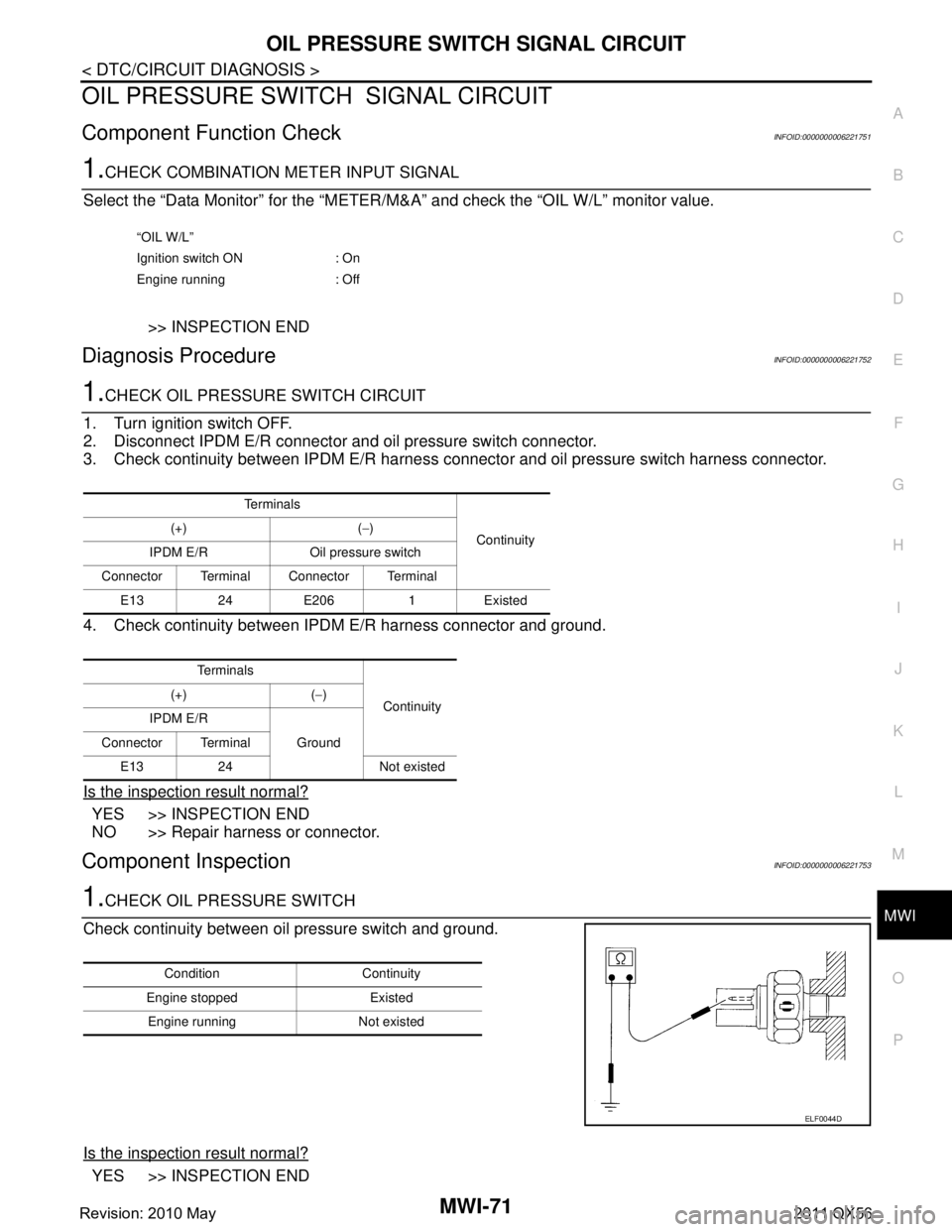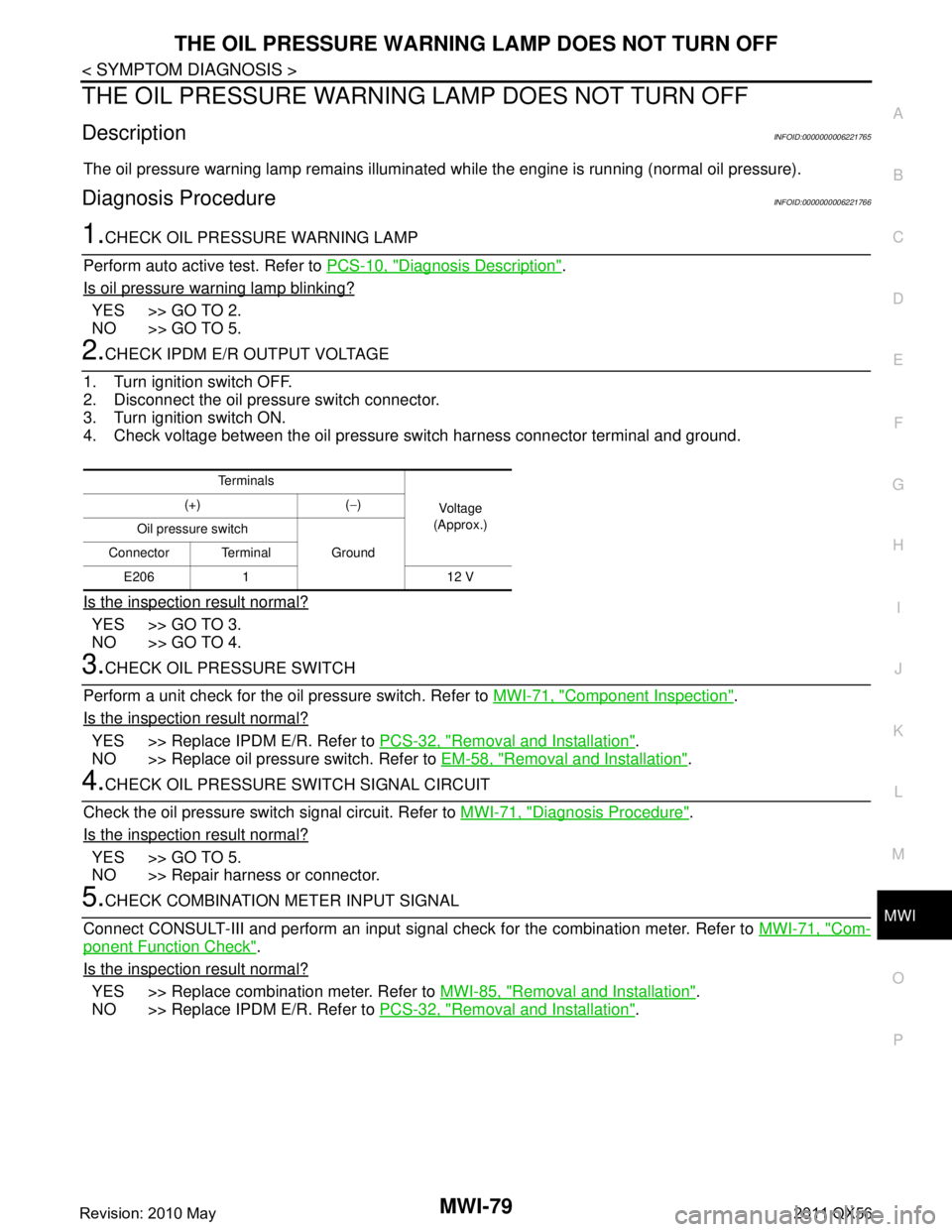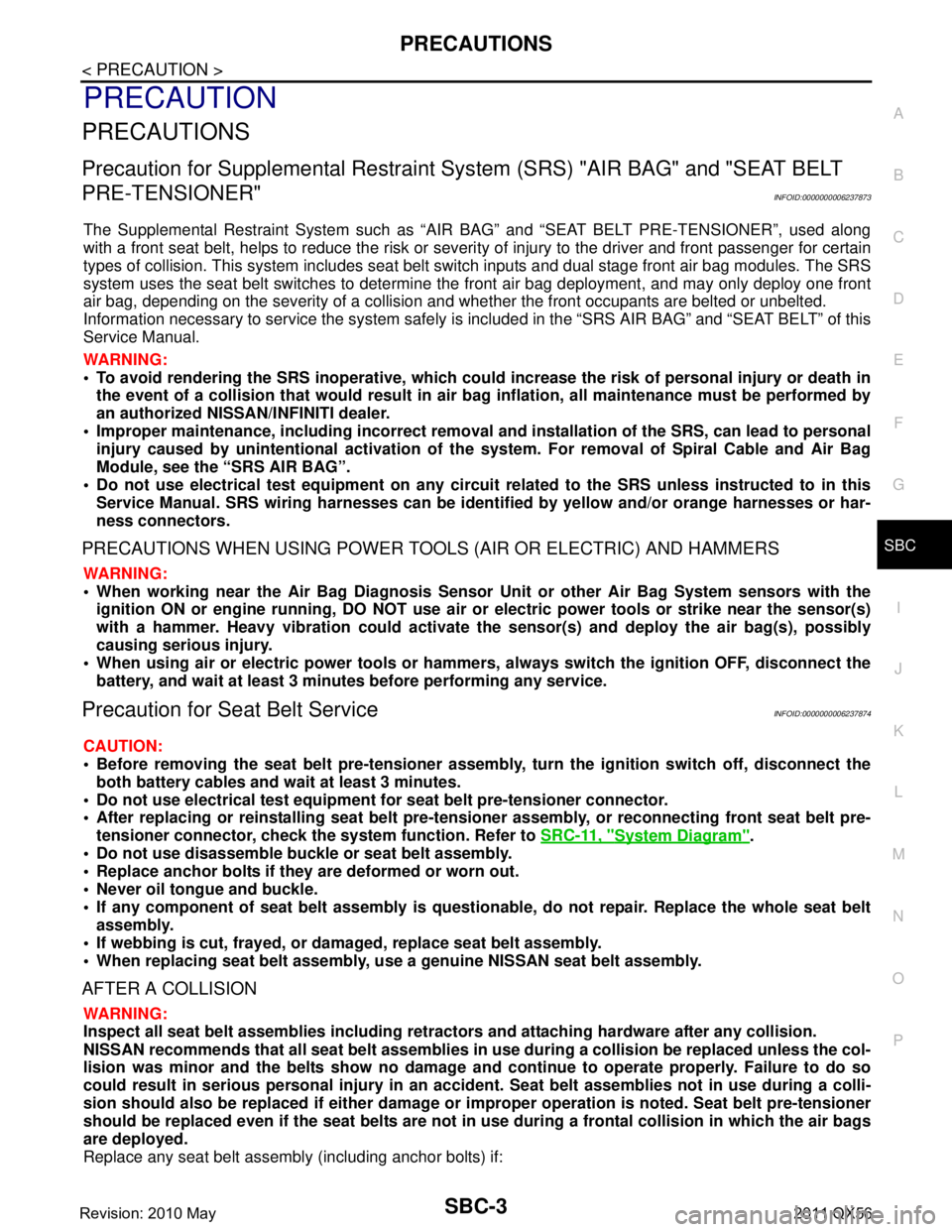2011 INFINITI QX56 engine oil
[x] Cancel search: engine oilPage 3814 of 5598

MWI
OIL PRESSURE SWITCH SIGNAL CIRCUIT
MWI-71
< DTC/CIRCUIT DIAGNOSIS >
C
D E
F
G H
I
J
K L
M B A
O P
OIL PRESSURE SWITCH SIGNAL CIRCUIT
Component Function CheckINFOID:0000000006221751
1.CHECK COMBINATION METER INPUT SIGNAL
Select the “Data Monitor” for the “METER/M& A” and check the “OIL W/L” monitor value.
>> INSPECTION END
Diagnosis ProcedureINFOID:0000000006221752
1.CHECK OIL PRESSURE SWITCH CIRCUIT
1. Turn ignition switch OFF.
2. Disconnect IPDM E/R connector and oil pressure switch connector.
3. Check continuity between IPDM E/R harness c onnector and oil pressure switch harness connector.
4. Check continuity between IPDM E/R harness connector and ground.
Is the inspection result normal?
YES >> INSPECTION END
NO >> Repair harness or connector.
Component InspectionINFOID:0000000006221753
1.CHECK OIL PRESSURE SWITCH
Check continuity between oil pressure switch and ground.
Is the inspection result normal?
YES >> INSPECTION END
“OIL W/L”
Ignition switch ON : On
Engine running : Off
Te r m i n a l s Continuity
(+) (
−)
IPDM E/R Oil pressure switch
Connector Terminal Connector Terminal E1324E2061Existed
Te r m i n a l s Continuity
(+) (
−)
IPDM E/R Ground
Connector Terminal
E13 24 Not existed
Condition Continuity
Engine stopped Existed Engine running Not existed
ELF0044D
Revision: 2010 May2011 QX56
Page 3822 of 5598

MWI
THE OIL PRESSURE WARNING LAMP DOES NOT TURN OFFMWI-79
< SYMPTOM DIAGNOSIS >
C
DE
F
G H
I
J
K L
M B A
O P
THE OIL PRESSURE WARNING LAMP DOES NOT TURN OFF
DescriptionINFOID:0000000006221765
The oil pressure warning lamp remains illuminated while the engine is running (normal oil pressure).
Diagnosis ProcedureINFOID:0000000006221766
1.CHECK OIL PRESSURE WARNING LAMP
Perform auto active test. Refer to PCS-10, "
Diagnosis Description".
Is oil pressure warning lamp blinking?
YES >> GO TO 2.
NO >> GO TO 5.
2.CHECK IPDM E/R OUTPUT VOLTAGE
1. Turn ignition switch OFF.
2. Disconnect the oil pressure switch connector.
3. Turn ignition switch ON.
4. Check voltage between the oil pressure switch harness connector terminal and ground.
Is the inspection result normal?
YES >> GO TO 3.
NO >> GO TO 4.
3.CHECK OIL PRESSURE SWITCH
Perform a unit check for the oil pressure switch. Refer to MWI-71, "
Component Inspection".
Is the inspection result normal?
YES >> Replace IPDM E/R. Refer to PCS-32, "Removal and Installation".
NO >> Replace oil pressure switch. Refer to EM-58, "
Removal and Installation".
4.CHECK OIL PRESSURE SWITCH SIGNAL CIRCUIT
Check the oil pressure switch signal circuit. Refer to MWI-71, "
Diagnosis Procedure".
Is the inspection result normal?
YES >> GO TO 5.
NO >> Repair harness or connector.
5.CHECK COMBINATION METER INPUT SIGNAL
Connect CONSULT-III and perform an input signal check for the combination meter. Refer to MWI-71, "
Com-
ponent Function Check".
Is the inspection result normal?
YES >> Replace combination meter. Refer to MWI-85, "Removal and Installation".
NO >> Replace IPDM E/R. Refer to PCS-32, "
Removal and Installation".
Te r m i n a l s
Voltag e
(Approx.)
(+) (
−)
Oil pressure switch Ground
Connector Terminal
E206 1 12 V
Revision: 2010 May2011 QX56
Page 3851 of 5598
![INFINITI QX56 2011 Factory Service Manual
PCS-10
< SYSTEM DESCRIPTION >[IPDM E/R]
DIAGNOSIS SYSTEM (IPDM E/R)
DIAGNOSIS SYSTEM (IPDM E/R)
Diagnosis DescriptionINFOID:0000000006220170
AUTO ACTIVE TEST
Description
In auto active test, the IPDM INFINITI QX56 2011 Factory Service Manual
PCS-10
< SYSTEM DESCRIPTION >[IPDM E/R]
DIAGNOSIS SYSTEM (IPDM E/R)
DIAGNOSIS SYSTEM (IPDM E/R)
Diagnosis DescriptionINFOID:0000000006220170
AUTO ACTIVE TEST
Description
In auto active test, the IPDM](/manual-img/42/57033/w960_57033-3850.png)
PCS-10
< SYSTEM DESCRIPTION >[IPDM E/R]
DIAGNOSIS SYSTEM (IPDM E/R)
DIAGNOSIS SYSTEM (IPDM E/R)
Diagnosis DescriptionINFOID:0000000006220170
AUTO ACTIVE TEST
Description
In auto active test, the IPDM E/R sends a drive si
gnal to the following systems to check their operation.
Oil pressure warning lamp
Rear window defogger
Front wiper (LO, HI)
Parking lamp
License plate lamp
Tail lamp
Side marker lamp
Front fog lamp
Headlamp (LO, HI)
A/C compressor (magnet clutch)
Operation Procedure
CAUTION:
Never perform auto active test in the following conditions.
Engine is running.
CONSULT-III is connected.
1. Close the hood and lift the wiper arms from the windshield. (Prevent windshield damage due to wiper
operation)
NOTE:
When auto active test is performed with hood opened, sprinkle water on windshield beforehand.
2. Turn the ignition switch OFF.
3. Turn the ignition switch ON, and within 20 seconds, pr ess the driver door switch 10 times. Then turn the
ignition switch OFF.
CAUTION:
Close passenger door.
4. Turn the ignition switch ON within 10 seconds. Af ter that the horn sounds once and the auto active test
starts.
CAUTION:
Engine starts when igniti on switch is turned ON while brake pedal is depressed.
5. The oil pressure warning lamp starts blinking when the auto active test starts.
6. After a series of the following operations is repeated 3 times, auto active test is completed.
NOTE:
When auto active test has to be cancelled halfway through test, turn the ignition switch OFF.
When auto active test is not activated, door swit ch may be the cause. Check door switch. Refer to DLK-117,
"ComponentFunctionCheck".
Inspection in Auto Active Test
When auto active test is actuated, the following operation sequence is repeated 3 times.
Operation
sequence Inspection location Operation
1 Oil pressure warning lamp Blinks continuously during operation of auto active test
2 Rear window defogger 10 seconds
3 Front wiper LO for 5 seconds → HI for 5 seconds
4 Parking lamp
License plate lamp
Tail lamp
Side marker lamp
Front fog lamp 10 seconds
Revision: 2010 May2011 QX56
Page 3857 of 5598
![INFINITI QX56 2011 Factory Service Manual
PCS-16
< ECU DIAGNOSIS INFORMATION >[IPDM E/R]
IPDM E/R
ST/INHI RLYIgnition switch ON Off
At engine cranking INHI ON
→ ST ON
The status of starter relay or starter control relay cannot be recogniz INFINITI QX56 2011 Factory Service Manual
PCS-16
< ECU DIAGNOSIS INFORMATION >[IPDM E/R]
IPDM E/R
ST/INHI RLYIgnition switch ON Off
At engine cranking INHI ON
→ ST ON
The status of starter relay or starter control relay cannot be recogniz](/manual-img/42/57033/w960_57033-3856.png)
PCS-16
< ECU DIAGNOSIS INFORMATION >[IPDM E/R]
IPDM E/R
ST/INHI RLYIgnition switch ON Off
At engine cranking INHI ON
→ ST ON
The status of starter relay or starter control relay cannot be recognized by
the battery voltage malfunction, etc. when the starter relay is ON and the
starter control relay is OFF. UNKWN
DETENT SW Ignition switch ON Pull the selector lever with selec-
tor lever in P position.
Selector lever in any position oth-
er than P. Off
Release the selector lever with selector lever in P position. On
S/L RLY -REQ None of the conditions below are present. Off
Open the driver door after the ignition switch is turned OFF (for a few
seconds).
Press the push-button ignition switch when the steering lock is activat-
ed. On
S/L STATE Steering lock is locked. LOCK
Steering lock is unlocked. UNLK
[DTC: B210A] is detected. UNKWN
OIL P SW Ignition switch OFF or ACC
Open
Ignition switch ON (engine running)
Ignition switch ON (engine stopped) Close
HOOD SW Close the hood Off
Open the hood On
HL WASHER REQ Not operating Off
Headlamp washer operating On
THFT HRN REQ Not operation Off
Panic alarm is activated
Theft warning alarm is activated
On
HORN CHIRP Not operation Off
Door locking with Intelligent Key (horn chirp mode) On
Monitor Item Condition Value/Status
Revision: 2010 May2011 QX56
Page 3859 of 5598
![INFINITI QX56 2011 Factory Service Manual
PCS-18
< ECU DIAGNOSIS INFORMATION >[IPDM E/R]
IPDM E/R
17
(B) Ground Cooling fan motor
ground
Output Ignition switch ON 0 V
18
(B) Ground Ground — Ignition switch ON 0 V
19
(V) Ground Front fog l INFINITI QX56 2011 Factory Service Manual
PCS-18
< ECU DIAGNOSIS INFORMATION >[IPDM E/R]
IPDM E/R
17
(B) Ground Cooling fan motor
ground
Output Ignition switch ON 0 V
18
(B) Ground Ground — Ignition switch ON 0 V
19
(V) Ground Front fog l](/manual-img/42/57033/w960_57033-3858.png)
PCS-18
< ECU DIAGNOSIS INFORMATION >[IPDM E/R]
IPDM E/R
17
(B) Ground Cooling fan motor
ground
Output Ignition switch ON 0 V
18
(B) Ground Ground — Ignition switch ON 0 V
19
(V) Ground Front fog lamp (RH) Output Lighting
switch 2ND or
AUTO (Light
is illuminated)Front fog lamp switch
OFF
0 V
Front fog lamp switch ON Battery voltage
20
(W) Ground Front fog lamp (LH) Output Lighting
switch 2ND or
AUTO (Light
is illuminated)Front fog lamp switch
OFF
0 V
Front fog lamp switch ON Battery voltage
21
(L) Ground
Headlamp washer re-
lay control Output
Ignition switch
ON Headlamp washer acti-
vated
0 V
Headlamp washer deacti-
vated 12 V
23
(GR/R) Ground Cranking request Output Select lever P or N (Ignition switch ON) 0 V
Select lever in any position other than P or
N (Ignition switch ON)
12 V
Engine running 12 V
24
(W/G) Ground Oil pressure switch Input Ignition switch
ONEngine stopped 0 V
Engine running 12 V
25
(L/Y) Ground Front wiper stop posi-
tion InputIgnition switch
ON Front wiper stop position 0 V
Any position other than
front wiper stop position
12 V
26
(P) Ground CAN-L Input/
Output ——
27
(L) Ground CAN-H
Input/
Output ——
30
(R/W) Ground Starter relay control Output Ignition switch OFF or ACC
At engine cranking
0 V
Ignition switch ON
Engine running 12 V
31
(B) Ground Injector relay control Output Approximately 1 second after turning
the ignition switch ON
Engine running 0 - 1.5 V
Approximately 1 second or more after turn-
ing the ignition switch ON Battery voltage
32
(LG) Ground Hood switch Input Close the hood 12 V
Open the hood 0 V
33
(R) Ground Alternator control Output Ignition switch OFF or ACC 0 V
Ignition switch ON 6 V
34
(P/B) Ground Horn relay control Output The horn is deactivated Battery voltage
The horn is activated 0 V
Te r m i n a l N O .
(Wire color) Description
Condition Va l u e
(Approx.)
Signal name Input/
Output
+–
Revision: 2010 May2011 QX56
Page 4257 of 5598

RSU-2
< PRECAUTION >
PRECAUTIONS
PRECAUTION
PRECAUTIONS
Precautions for SuspensionINFOID:0000000006225656
• When installing rubber bushings, the final tightening must be carried out under unladen conditions with tires
on ground. Spilled oil might shorten the life of rubber bushings. Be sure to wipe off any spilled oil.
- Unladen conditions mean that fuel, engine coolant and l ubricant are full. Spare tire, jack, hand tools and
mats are in designated positions.
After servicing suspension parts, be sure to check wheel alignment.
Self-lock nuts are not reusable. Always use new ones when installing. Since new self-lock nuts are pre-oiled,
tighten as they are.
Revision: 2010 May2011 QX56
Page 4300 of 5598

PRECAUTIONSSBC-3
< PRECAUTION >
C
DE
F
G
I
J
K L
M A
B
SBC
N
O P
PRECAUTION
PRECAUTIONS
Precaution for Supplemental Restraint System (SRS) "AIR BAG" and "SEAT BELT
PRE-TENSIONER"
INFOID:0000000006237873
The Supplemental Restraint System such as “A IR BAG” and “SEAT BELT PRE-TENSIONER”, used along
with a front seat belt, helps to reduce the risk or severi ty of injury to the driver and front passenger for certain
types of collision. This system includes seat belt switch inputs and dual stage front air bag modules. The SRS
system uses the seat belt switches to determine the front air bag deployment, and may only deploy one front
air bag, depending on the severity of a collision and whether the front occupants are belted or unbelted.
Information necessary to service the system safely is included in the “SRS AIR BAG” and “SEAT BELT” of this
Service Manual.
WARNING:
• To avoid rendering the SRS inoper ative, which could increase the risk of personal injury or death in
the event of a collision that would result in air ba g inflation, all maintenance must be performed by
an authorized NISSAN/INFINITI dealer.
Improper maintenance, including in correct removal and installation of the SRS, can lead to personal
injury caused by unintentional act ivation of the system. For removal of Spiral Cable and Air Bag
Module, see the “SRS AIR BAG”.
Do not use electrical test equipm ent on any circuit related to the SRS unless instructed to in this
Service Manual. SRS wiring harnesses can be identi fied by yellow and/or orange harnesses or har-
ness connectors.
PRECAUTIONS WHEN USING POWER TOOLS (AIR OR ELECTRIC) AND HAMMERS
WARNING:
When working near the Air Bag Diagnosis Sensor Unit or other Air Bag System sensors with the
ignition ON or engine running, DO NOT use air or electric power tools or strike near the sensor(s)
with a hammer. Heavy vibration could activate the sensor(s) and deploy the air bag(s), possibly
causing serious injury.
When using air or electric power tools or hammers , always switch the ignition OFF, disconnect the
battery, and wait at least 3 minutes before performing any service.
Precaution for Seat Belt ServiceINFOID:0000000006237874
CAUTION:
Before removing the seat belt pre-tensioner assembly, turn the ignition switch off, disconnect the
both battery cables and wait at least 3 minutes.
Do not use electrical test equipment for seat belt pre-tensioner connector.
After replacing or reinstalling seat belt pre-tens ioner assembly, or reconnecting front seat belt pre-
tensioner connector, check the system function. Refer to SRC-11, "
System Diagram".
Do not use disassemble buckle or seat belt assembly.
Replace anchor bolts if th ey are deformed or worn out.
Never oil tongue and buckle.
If any component of seat belt assembly is questio nable, do not repair. Replace the whole seat belt
assembly.
If webbing is cut, frayed, or damaged, replace seat belt assembly.
When replacing seat belt assembly, u se a genuine NISSAN seat belt assembly.
AFTER A COLLISION
WARNING:
Inspect all seat belt assemblies including retractors and attaching hardware after any collision.
NISSAN recommends that all seat belt assemblies in u se during a collision be replaced unless the col-
lision was minor and the belts show no damage a nd continue to operate properly. Failure to do so
could result in serious personal injury in an accide nt. Seat belt assemblies not in use during a colli-
sion should also be replaced if either damage or im proper operation is noted. Seat belt pre-tensioner
should be replaced even if the seat belts are not in use during a frontal collision in which the air bags
are deployed.
Replace any seat belt assembly (including anchor bolts) if:
Revision: 2010 May2011 QX56
Page 4463 of 5598

SE-4
< PRECAUTION >
PRECAUTIONS
PRECAUTION
PRECAUTIONS
Precaution for Supplemental Restraint System (SRS) "AIR BAG" and "SEAT BELT
PRE-TENSIONER"
INFOID:0000000006237842
The Supplemental Restraint System such as “A IR BAG” and “SEAT BELT PRE-TENSIONER”, used along
with a front seat belt, helps to reduce the risk or severi ty of injury to the driver and front passenger for certain
types of collision. This system includes seat belt switch inputs and dual stage front air bag modules. The SRS
system uses the seat belt switches to determine the front air bag deployment, and may only deploy one front
air bag, depending on the severity of a collision and w hether the front occupants are belted or unbelted.
Information necessary to service the system safely is included in the “SRS AIR BAG” and “SEAT BELT” of this
Service Manual.
WARNING:
• To avoid rendering the SRS inopera tive, which could increase the risk of personal injury or death in
the event of a collision that would result in air bag inflation, all maintenance must be performed by
an authorized NISS AN/INFINITI dealer.
Improper maintenance, including in correct removal and installation of the SRS, can lead to personal
injury caused by unintent ional activation of the system. For re moval of Spiral Cable and Air Bag
Module, see the “SRS AIR BAG”.
Do not use electrical test equipmen t on any circuit related to the SRS unless instructed to in this
Service Manual. SRS wiring harnesses can be identi fied by yellow and/or orange harnesses or har-
ness connectors.
PRECAUTIONS WHEN USING POWER TOOLS (AIR OR ELECTRIC) AND HAMMERS
WARNING:
When working near the Air Bag Diagnosis Sensor Unit or other Air Bag System sensors with the ignition ON or engine running, DO NOT use air or electric power tools or strike near the sensor(s)
with a hammer. Heavy vibration could activate the sensor(s) and deploy the air bag(s), possibly
causing serious injury.
When using air or electric power tools or hammers , always switch the ignition OFF, disconnect the
battery, and wait at least 3 minu tes before performing any service.
Service NoticeINFOID:0000000006217352
When removing or installing various parts, place a cloth or padding onto the vehicle body to prevent
scratches.
Handle trim, molding, instruments, grille, etc. carefull y during removing or installing. Be careful not to oil or
damage them.
Apply sealing compound where necessary when installing parts.
When applying sealing compound, be careful that t he sealing compound never protrudes from parts.
When replacing any metal parts (for example body outer panel, members, etc.), always take rust prevention
measures.
Precaution for WorkINFOID:0000000006217353
When removing or disassembling each component, be careful not to damage or deform it. If a component
may be subject to interference, al ways protect it with a shop cloth.
When removing (disengaging) components with a screwdriver or similar tool, always wrap the component
with a shop cloth or vinyl tape to protect it.
Protect the removed parts with a shop cloth and keep them.
Replace a deformed or damaged clip.
If a part is specified as a non-reusable part, always replace it with new one.
Always tighten bolts and nuts securely to the specified torque.
After reinstallation is complete, always check that each part works normally.
Follow the steps below to clean components.
- Water soluble foul: Dip a soft cloth into lukewarm water, and wring the water out of the cloth to wipe the fouled area.
Then rub with a soft and dry cloth.
Revision: 2010 May2011 QX56